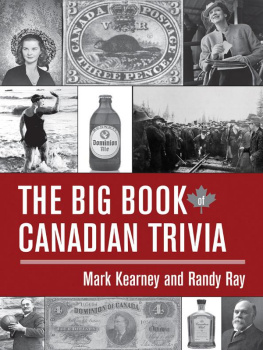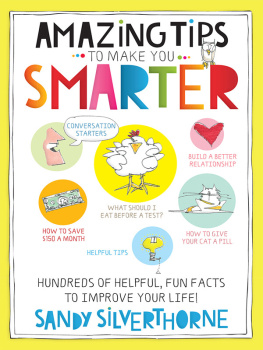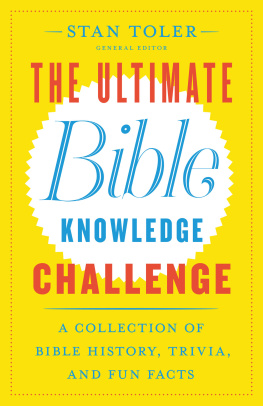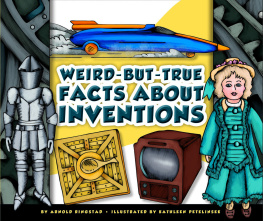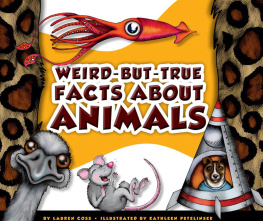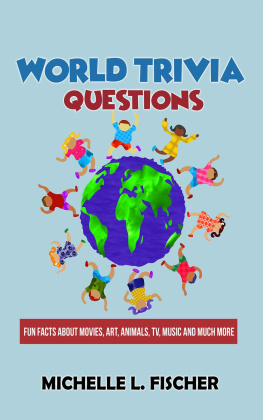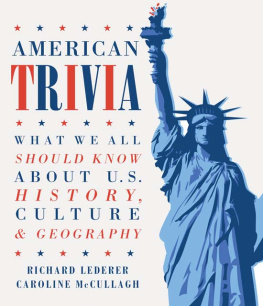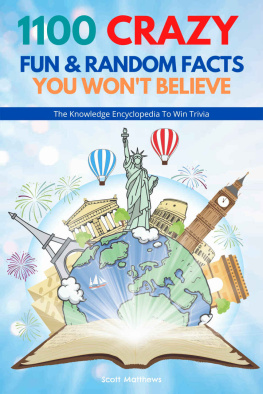Smarter Every Day
facts, trivia, & general knowledge
Elsmere Gracey
2019 by Elsmere Gracey
All rights reserved. No portion of this book may be reproduced, stored in a retrieval system, or transmitted in any form or by any means electronic, mechanical, photocopy, recording, scanning, or other except for brief quotations in critical reviews or articles, without the prior written permission of the publisher. It may not be circulated in any form of binding or cover other than that in which it is published.
Dedicated to you, the reader, who shares the same passion for knowledge.
Also available on Amazon and Kindle
- Clever Knickers Facts & General Knowledge.
- Smarter Than Yesterday Facts, Trivia, & General Knowledge.
- The Enemy of Ignorance Facts, Trivia, & General Knowledge.
- Extracts from the Smarty Pants Series (Kindle only)
Knowledge is the treasure of a wise man.
William Penn (1644 - 1718)
Develop a passion for learning. If you do, you will never cease to grow.
Anthony J. DAngelo (1920 2006)
Knowledge has a beginning but no end.
Greeta Lyengar (1944 2018)
There is much pleasure to be gained from useless knowledge.
Bertrand Russell (1872 1970)
Anyone who stops learning is old, whether at twenty or eighty!
Henry Ford (1863 1947)
The Walt Disney Company is the largest consumer of fireworks in the world, and the second-largest purchaser of explosive devices the U.S. Department of Defense is the first.
The secret members-only club called Club 33 is based at Disneyland and was initially designed as a place for Walt Disney to entertain guests and business associates.
Located in the centre of New Orleans Square, it is the only place in the park that serves alcohol.
Different levels of membership can be purchased with prices ranging from $25k to $100k (around 20k to 80k); the ongoing annual fee ranges from $12,500 to $30k (10k to 24k). There is a ten-year waiting list, but one of the benefits of being a member is getting early admission to the park and being able to avoid the queues.
It was rumoured that Walt Disney was a 33 rd -degree Mason, which is why the club was named Club 33. It is reported that much of the dcor, especially floor tiles and window frames, mimic symbols and shapes associated with Masons and their ceremonies.
The wave-like blob of toothpaste applied to a toothbrush is called a nurdle .
During 2010, a nurdle was the basis for a legal battle between two of the worlds largest toothpaste makers who both filed a lawsuit against each other on the same day. The companies, Colegate Palmolive and GlaxoSmithKline, were attempting to stop the other from depicting a nurdle on their packaging. The dispute was finally settled the following year when they announced that a settlement had been agreed.
Random thought brushing your teeth is the only time you clean your skeleton!
The worlds oldest-known formula for toothpaste was recently discovered written on a piece of dusty papyrus in the basement of a Viennese museum. Dating back to the 4th century A.D. the document listed the ingredients as one drachma of rock salt, two drachmas of mint, one drachma of dried iris flowers, and 20 grains of pepper.
(One drachma measured about 4.3 grams).
In Ancient Greece, dentists extracted venom from the spines of stingrays to use as a local anaesthetic.
In 1975, James Kemper invented and patented the vacuum toilets used in aeroplanes. The invention was installed in Boeing planes in 1982.
The bowl is non-stick; the blue substance used in place
of water is known as Skykem, which kills odours and disinfects the bowl.
When the pneumatic toilet is flushed, the vacuum removes the contents from the bowl at a speed that has been recorded as faster than a Formula 1 race car. The waste then travels through pipes to the rear of the plane where it remains in a tank. Once the plane lands, the hose of a service vehicle is attached to the container to drain the contents before it is disinfected.
A plane cannot legally commence take-off if a passenger is using the toilet.
Random thought - home is where the most trusted toilet seat is!
The typical eight to nine-minute shower uses about 65 litres/17 gallons of water.
Completed in 1752, and recognised as a symbol of freedom in the United States of America, the Liberty Bell was moved from Philadelphia during 1777 to be hidden in a church in the small city of Allentown due to the growing fear that the British would melt it down to make cannons - it was reinstated the following year.
The bell was first called Liberty Bell around 1839 by
abolitionist publications. Previously it had been known
as the State House Bell and the Province Bell.
The words from the Old Testament book, Leviticus Chapter 25, verse 10, are inscribed on the bell Proclaim liberty throughout all the land unto all the inhabitants thereof.
Although Pennsylvania is spelt Pensylvania on the bell, it is not considered to be an error as it was commonly spelt that way at that time.
William Howard Taft (18571930) was the 27 th President of the United States (1909 to 1913) and the only president to bring his own cow with him when moving into the White House. Unfortunately, his cow named Mooly Wooly died shortly afterwards. It was replaced by one named Pauline Wayne which was gifted by a congressman from Wisconsin. Milk was still scarce at that time, but Pauline was able to supply Taft and his family with an ample supply as she produced approximately eight gallons per day. White House guests were able to purchase surplus amounts for $0.50 per bottle. Pauline was quickly drawn into the public eye and even visited dairy exhibitions, and cow shows when Tafts busy schedule didnt permit him to attend. However, during one of her engagements (when she was travelling by private train), she went missing. The news was broadcast (via telegrams) by White House officials, and after a frantic search, Pauline was located in a slaughterhouse holding pen just in time to evade being slaughtered.
Pauline retired to a Wisconsin farm today her cowbell rests in the Presidential Pet Museum in Williamsburg, Virginia.
Campanology is the study of bells and incorporates the technology of how they are cast, tuned, rung, and sounded. It also includes the history, methods, and traditions of bell-ringing.
Someone who studies bells is known as a campanologist .
Bells are made from Bell Metal - a mixture of 78% copper and 22% tin.
China is believed to be the birthplace of bells as the Chinese people used them to make important announcements, to warn the people about an impending danger, and to worship their gods. A record of the first bell can be traced back to 2,000 B.C.
The largest bell that still exists is the Tsar Bell in Moscow, Russia. It is also known as the Tsarsky Kolokol, Royal Bell, or Tsar Kolokol III. It is made of bronze and has never been rung because it was cracked during a fire just after being finished. It stands at 20.1 ft (6.14 meters) and has a diameter of 22 ft (6.6 metres).
At the height of 12 ft (3.66 metres), the Mingun Bell, located in Myanmar (formerly Burma), is the largest bell that still rings.


